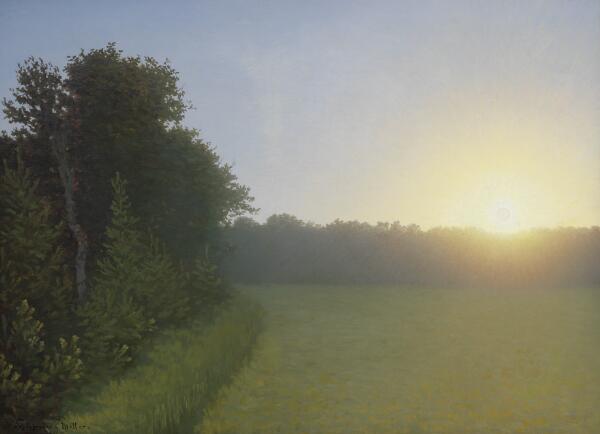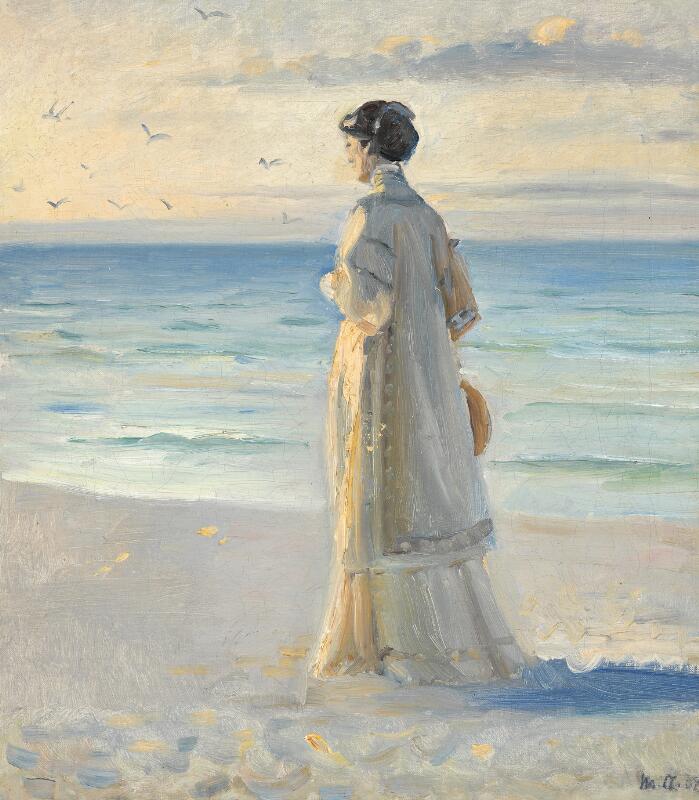The Sunny Side of Denmark in 1900
We know them so well, the elegant ladies and sauntering flâneurs in Paul Fischer's Copenhagen paintings and the Skagen painters' equally popular depictions of the artist colony's usual suspects. At the auction in Copenhagen, we focus on life in Denmark around the turn of the century – primarily depicted from the sunny side of life.
At this summer auction, we can present eight paintings by the Copenhagen painter Paul Fischer and several motifs from Skagen by P.S. Krøyer, Anna Ancher and Michael Ancher. All over Denmark, these artists unfolded their artistic efforts during the Modern Breakthrough (1870-1914). It was a time when Danish society's entrenched norms were questioned and debated, and where the consequences of industrialization and urbanization could truly be felt. During one of his controversial lectures in the 1870s, Professor Georg Brandes stated: "If literature comes alive in our day it is because it puts the spotlight on social issues". These words became crucial to the spiritual and cultural life of the time –also in the visual arts. To be critical in one’s art was seen as important, but for Fischer and to some extent the artists in Skagen, this did not set an overriding agenda for their art. Despite great differences in painting style, selection of motifs and temperament, they had one thing in common – they did not necessarily follow the socially critical currents of the time and primarily wanted to do something else with their art.
Paul Fischer – the Painter of Copenhagen
The highlight among this summer's many works by Fischer is the festive and atmospheric "The Royal Guard in Red Uniforms". Here we are on Strøget, where the Royal Guard is wearing red uniforms on the occasion of Christian X's birthday. The Danish flags flutter in the wind, and we see both the women of the bourgeoisie wearing fashionable clothes, fine gentlemen on their way home from the office and cheeky messenger boys with cigarettes in the corner of their mouths.
"Copenhagen at the turn of the century was in his paintings – a topography that will only gain in interest as each of the city's features from that time disappears – there was always a Copenhagen state-of-mind present in even his less important Christmas card drawings".
Obituary, Berlingske Tidende
No one has depicted the Danish capital as thoroughly as Fischer, who with his art reminds us of the decades around the year 1900 when Copenhagen had got rid of its surrounding ramparts and developed into a modern city. As the auction's selection shows us, Fischer primarily took his starting point in the older, neater part of Copenhagen, and the main characters are representatives of the bourgeoisie. They are occasionally accompanied by florists and fishwives from the lower strata of society, but the interaction between people in the cityscape always takes place in harmonious tolerance. With Fischer, we never move down the side streets and into one of the many dirty backyards of the time. The city's darker sides and social criticism of its challenges was not something that Fischer went looking for, and with him, we get a wonderful but idyllic depiction of Copenhagen around 1900.
|
|
Nature and the Artist Colony in Skagen
Several leading artists of the time had relocated to a place more than 500 km away from Copenhagen. They preferred the way of life, the light and the sea at Denmark's northernmost point in Skagen. Here, they established a creative community and attracted great cultural personalities from all over Scandinavia. Georg Brandes visited Skagen several times and greatly appreciated the nature, the members of the artist colony and the cultural debates around the dinner table at Brøndums Hotel.
“The air here seems ‘higher’ than elsewhere, just as the horizon is actually wider. Nowhere does the eye enjoy the heaven and sea as much (…). The main characters of Skagen are the air and the sea, a disparate and yet cohabitating pair, a changeable one which at the same time shines and is quiet, at the same time tender and blushing, at the same time darkening, angry and storming. In the nature of Skagen, nothing is small, and nothing is restricted. In Skagen, one can draw the fullest breath. Here we breathe the deepest (…). When I spent a few days at Skagen last year, it was 26 years since I had last lived in the artists' colony and divided my time between dips in the sea and meals with cheerful, endless debates.”
Georg Brandes, 1910.
|
Perhaps it was precisely the nature that made Skagen the gathering place of these aesthetes. The most famous painters lived permanently in the town, and most of the main subjects in their motifs belonged to the artist colony or were close relations. Many of the Skagen works – also at this auction – thus portray a well-off Denmark among the creative, intellectual upper class. But unlike Fischer, the Skagen painters also had another goal, which was more along the lines of the ideas behind the Modern Breakthrough. They also portrayed the less affluent locals and their living conditions, such as the fishermen, in an almost realistic light. |
|
|
|
|
|
Krøyer's portrait from 1909 of his young daughter Vibeke wearing an adorable white dress is this time the highlight from Skagen. The beautiful work was one of the final paintings made by Krøyer. It is from a time when he had become an internationally recognized artist, and he had just exhibited several of his masterpieces at the Venice Biennale. However, life was coming to an end for Krøyer, whose manic-depressive nature and treatment with mercury made him increasingly ill. As a contrast to the freshness and youth that Vibeke represents in this portrait, she stands on the threshold of adulthood with a thoughtful and melancholy expression on her face – perhaps because the object of her gaze is her ill father. The portrait stood on the easel in Krøyer's home, where he could look at it every day in the months leading up to his death in the autumn of 1909. |

For further information, please contact:
Julie Arendse Voss: +45 8818 1123 · jav@bruun-rasmussen.dk
Birte Stokholm: +45 8818 1122 · bst@bruun-rasmussen.dk
Søren Kjerk Holmstrup: +45 8818 1127 · skh@bruun-rasmussen.dk



